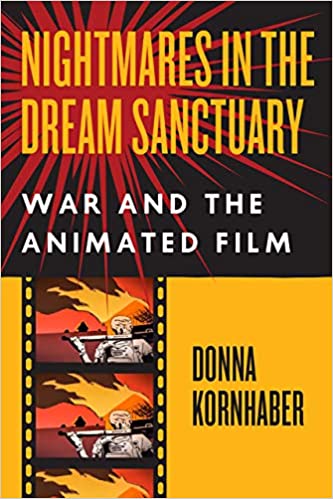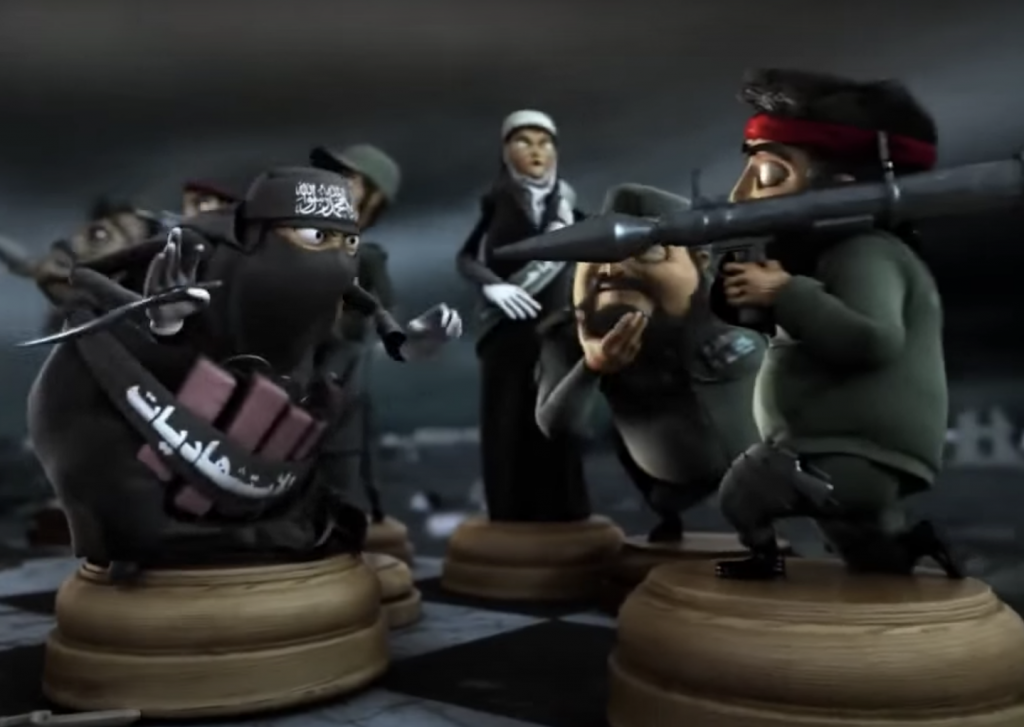Review of Donna Kornhaber, Dream Sanctuary: War and the Animated Film. Chicago/London: University of Chicago Press, 2020.

When one thinks about wartime animated films, propaganda film comes to most people’s mind. Indeed, since the 1990s, studies in animated propaganda developed into a large field of academic study. However, while propaganda remains a large part of war, war is also genocide, nuclear annihilation, memory, trauma, child soldiers, invaders, occupiers, kamikazes, insurgents, partisans and bystanders, which one rarely hears about. As far as animation is concerned, witnesses of war and their lived experience of armed conflict are often left behind, and this is exactly what Donna Kornhaber tries to put to light in her book Nightmares in the Dream Sanctuary: War and the Animated Film (2020).
Kornhaber’s argument is based on the concept of witnessing in animation as opposed to create propaganda. She argues that propagandist animation generally urges, glorifies or justifies war, but it rarely shows what war is. In opposition, animation can also bear witness and transform war’s atrocity into art. To bear witness is to render the invisible into images, or more simply to show what has not yet been shown – to testifying of one’s experience and to fill in the empty blanks left from history. With this concept, she proposes another model for animation: one that actively turns towards history with eyes open instead of turning away from it. For Kornhaber, bearing witness can be expressed through different forms: resistance, pacifism, memory, and memorial.

Nightmares in the Dream Sanctuary is organized in two parts. Part one, At War, presents witnessing as resistance and pacifism. Kornhaber argues that resistance animation generally comes from within the state at war and opposes the official state’s discourse. It denounces an occupation of the state or its abusive military actions towards another nation. Resistance animation uses both allegory and symbolism to talk about armed conflict, making animation’s voice subversive. In this section, Kornhaber addresses resistance, protest animation (from democratic countries), and ex post facto propaganda (postwar animation created by the people who are now liberated and expressing revenge fantasies). The second chapter in this section,“Pacifism”, focuses on films that arise in the midst of a specific armed conflict. While protesting against it, they take no side and tend to remain an impassioned call against war-making itself. Typically, war’s terrible violence is part of these films and human experience remains central to its message. Kornhaber examines proto-pacifism animation of the 1920s or films that anticipated pacifist animation. She also addresses later films criticizing the escalation of violence and its casualties, such as Norman McLaren’s Neighbours (1952) or Ivan Ramadan’s Tolerance (2006).

The second part of Kornhaber’s book, After War, is concerned with memory and memorial, where animated films both document reality and express one’s personal experience of war. As memory is often a collaged and contradictory affair, the films also tend to be fragmented and resistant to the coherence of a storyline. Memory films are really about expressing the artist’s struggle in representing the unrepresentable rather than protesting or promoting war. In Memory, Kornhaber examines remembering and forgetting war through biographical animation and memories, PTS(D), identity formation, and how to survive traumatic memories. The final chapter of After War is concerned with memorial, or animated films that commemorate the dead. Memorial animation is at the intersection of remembrance and fantasy, because their author imagines or reconstructs events he never took part in and that were never recorded before. Often a mix of historical elements and imagination, memorial films seek to enter history and national consciousness so the casualties of war can never be forgotten. In this section, Kornhaber examines diverse memorial and testimonial films, child soldiers experience, and she presents a special section dedicated to the Holocaust, Hiroshima and Nagasaki.
With Nightmares in the Dream Sanctuary, Kornhaber offers a unique encounter of how to critically approach different types of animated war films. She addresses complex philosophical questions related to war and skillfully links them to tangible animated films. The film analysis she provides are all put in context making her topic accessible and understandable for any reader. She also demonstrates how the animators’ aesthetical choices can express emotion, trauma, and war memories. Overall, Kornhaberbuilt a solid, accessible, and well-balanced volume. My main criticism concerns her perception of history that I find a bit negative. For example, she argues that history, by trying to organize historical facts and events into a vanquisher/vanquished dichotomy, has kept witnessing is the realm of history’s discontinuum. While this claim is not entirely wrong, it does not take into account the fields of social and people’s history which keep witnesses and human experience at the core of their research. In this light, history and witnessing sounds mutually exclusive.
Nevertheless, I highly recommend Nightmares in the Dream Sanctuary as this short but dense volume intelligibly articulates new approaches to animated war films. I was particularly delighted to see Kornhaber addressing many animated films from various countries that we do not often hear about. Furthermore, she made sure to incorporate many different techniques of animation including classical animation, paper cut, stop-motion, mix media, puppets, and CGI. With this book, what Kornhaber really demonstrates is the universality of conflict and war, and perhaps how animation’s essence is also universally human.
Genia Boivin received her Ph.D. and MA in Modern Languages and Cultural Studies from the University of Alberta, and degrees in Art History and Film Studies from Concordia University (BFA) and Université de Montréal. Her doctoral research focused on the representation of identity, ideology, and national imagination expressed in animation film. Genia’s research interests include film, video games, media theory, Eastern European cinema, visual art, and performance. Her most recent publication is a course manual that examines archetypes and mythology expressed in contemporary news coverage. Genia has been teaching at the University of Sudbury in the Department of Culture and Communication since 2011.
